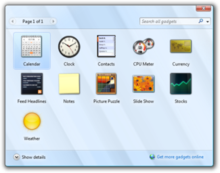- Microsoft Gadgets
-
This article is part
of a series onNew featuresOverview
Technical and core system
Security and safety
Networking technologies
I/O technologies
Management and administration
Removed featuresOther articles
Microsoft Gadgets are lightweight single-purpose applications, or software widgets, that can sit on a Microsoft Windows user's computer desktop, or are hosted on a web page. According to Microsoft, it will be possible for the different types of gadgets to run on different environments without modification, but this is currently not the case.
Contents
Etymology
In the context of software engineering, the term gadget was first employed by the developers of AmigaOS, the operating system of the Amiga computers in 1985.[citation needed] As of 2008, this naming convention is sometimes used as a synonym for widget—a control element in a graphical user interface.
It is not known whether other software companies are explicitly drawing on that inspiration when featuring the word in names of their technologies or simply referring to the generic meaning. The word widget is older in this context.
Types of Microsoft's gadgets
- Web gadgets - run on a web site, such as Bing.com or Spaces.
- Sidebar gadgets - run on the desktop or be docked onto, run on the Windows Sidebar.
- SideShow gadgets - run on auxiliary external displays, such as on the outside of a laptop or even on an LCD panel in a keyboard, and potentially mobile phones and other devices.
Web gadgets and Live.com
Web gadgets run on Web sites such as Live.com and Windows Live Spaces
Live.com lets users add RSS feeds in order to view news at a glance. Building off Microsoft's start.com experimental page, Live.com can be customized with Web Gadgets, mini-applications that can serve almost any purpose (e.g. mail readers, weather reports, slide shows, search, games, etc.). Some gadgets integrate with other Windows Live services, including Mail, Search, and Favorites.
Users can create multiple site tabs and customize each with different feeds, gadgets, layouts, and color schemes.
Desktop gadgets
Main article: Windows SidebarDesktop gadgets are desktop widgets; small specialized applications that are generally designed to do simple tasks, such as clocks, calendars, RSS notifiers or search tools. They can also be used to control external applications such as Windows Media Center.
A panel, or sidebar, is found on either the right side (default) or the left side of the Windows desktop in the Windows Vista operating system. Gadgets can be placed on this sidebar, and they are automatically aligned on it. Gadgets can also be placed elsewhere on the screen, which generally causes them to expand and display more information. In Windows 7, the sidebar is removed, although gadgets can somewhat similarly be aligned on any side of the screen. Gadgets are toggled between the two sizes via a button in Windows 7.
Device gadgets and Windows Sideshow
Windows SideShow is a new technology that lets Windows Vista drive auxiliary, small displays of various form-factors where ready-access to bite-size bits of information could be represented. These include displays embedded on the outside of a laptop lid or on a detachable device, enabling access to information and media even when the main system is in a standby mode. Data can also be displayed on cell phones and other network-connected devices via Bluetooth and other connectivity options.
The display can be updated with a number of different kinds of information, such as contacts, maps, calendar, and email. This can then be consulted while the mobile PC is otherwise powered down. Since the underlying platform is so power-efficient, it can run for hundreds of hours without draining a notebook battery, while still providing always-on access to data and multimedia content.
Sideshow is coupled to the Windows Vista Sidebar capability – that is, Sidebar Gadgets are easily ported to be compatible with Sideshow secondary display applications. However, hardware and silicon providers can also provide native capabilities to allow for richer multimedia applications such as text, image, audio and video decode / playback. For example, a notebook with an in-lid display could be used as an mp3 player while powered down, with the notebook battery providing hundreds of hours of playback time because of the low power footprint that the Sideshow platform maintains.
See also
Further reading
References
External links
- Windows Vista sideshow devices website
- Sidebar gadget developers forum on Microsoft Developer Network forums
- Gadgets gallery at Live.com
- Windows Desktop and Sideshow gadgets home page
Widget engines (Comparison) Modes 
Engines adesklets · AveDesk · Dashboard · DesktopX · gDesklets · Google Desktop Gadgets · Kapsules · KlipFolio · Microsoft Gadgets · NetFront · Netvibes · Opera · KDE Plasma Workspaces · Screenlets · Serious Samurize · SuperKaramba · WebKit · WidSets · Yahoo! WidgetsCategories:- Windows Vista
- Microsoft software
- Widget engines
Wikimedia Foundation. 2010.

